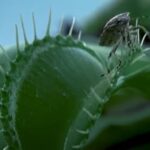As an Amazon Associate, this site earns commissions from qualifying purchases. For more details, click here.
Venus flytraps need more water than the typical plant, but is that all the plant needs? What will happen if all you give your Venus flytrap is water? It is an interesting question which we will discuss here in depth. If you have one of these carnivorous plants, knowing the answer is key to nurturing it.
Venus flytraps cannot survive on just water because they require sunlight for photosynthesis. These plants also need flies, spiders and other insects to meet their nutritional requirements.
Do Venus Flytraps Need More Than Just Water?
All plants require water and Venus flytraps are no exception. Carnivorous plants depend on water to move nutrients and is used for photosynthesis. But they also require sunlight and nourishment.
Venus flytraps grow in savannas and grasslands, indicative of how much water they require. One of the first things you learn about these plants that they need plenty of this to survive. All living things depend on water to live, and since plants are alive they are no exception.
But water alone is insufficient. Venus flytraps also depend sunlight to create glucose, which serves as their “food” or fuel. Venus flytraps do not necessarily require sunlight to do this – it can be done with artificial lighting – but natural light is better.
Venus flytraps grow in nutrient poor soil so they get nutrients from other sources, namely insects. Photosynthesis provides food for these plants, while insects supply them with nutrition.
Venus flytraps can live without insect nutrients, but not sunlight. But for the best results your plant should have access to water, sunlight, soil and nutrients.
Plants that receive the right amount of water are healthier. You can tell because the leaves are green and in the case of flytraps, the lobes are reddish and the rhizome (the bulb) is white.
A lot of this can be attributed to water, and like we said the plant cannot survive without it. But you should not deprive the plant of sunlight and nutrition.
Without light there is no way Venus flytraps can create food. Without insects, these plants will have no access to nutrients.
You cannot fertilize a Venus flytrap soil. Doing so will harm the plant and might kill it. You should let the plant catch insects and obtain its nutrients there instead of through fertilizers. Bottom line: water is essential but so are light and nutrients.
How Often Should I Water a Venus Flytrap?
The soil of a Venus flytrap must always be moist, so water as often as necessary. During summer this might mean watering every day, but for the other months about every 2-3 days.
Do not let the soil dry out. When the dampness is about to wear off, add more water. During hot days you might need to water twice a day, and during cool periods less often.
Use only distilled, rain or reverse osmosis water. Venus flytraps will not thrive with tap water because they contain elements detrimental to the plant. Our choice is Smartwater because it is 100% safe for plants including Venus flytraps.
Dormant Venus flytraps need less water, usually every week or so is enough. The soil should still be kept damp but not so wet.
How to Check Soil Moisture
Here’s a tip: touch the soil with your finger. Some soil and moss bits should stick but it must not feel wet. If you added long fiber sphagnum it should feel moist but not wet.
If you press the moss and water comes out, the soil is drenched. There is way too much water and you need to reduce watering.
You can avoid getting your fingers dirty by using a moisture sensor like Sonkir Soil PH Meter. With this you will know right away if the soil is dry, wet or just moist enough for your plant.
Keep in mind that your watering schedule must be flexible. Plants will need more during summer and less in winter. The interval between watering will also depend on the Venus flytrap.
The watering frequency given here are for guidelines only. In some cases it will fit your situation. You might indeed need to water your Venus flytrap daily during summer and every two days for other months.
But in other instances this might not be applicable. If you water the plant today and the next day it is still moist, there is no reason to do it again.
Do not stick to a rigid watering schedule. Let the dampness of the soil be your guide. The key here is to keep the soil moist but not too wet. You could end up overwatering a Venus flytrap and that can cause problems like root rot.
Should I Keep My Venus Flytrap in Water?
Venus flytraps should always be kept damp. Put the plant in a pot with drainage holes and place it on a tray with an inch of water. Refill the tray with water once the soil soaks it all up.
The easiest way to water a Venus flytrap is to use the tray method. Get a pot with drainage and plant your Venus flytrap there.
All you need to do is place a the pot on a tray and add an inch or two of water in it. Some growers only add a third of an inch so it is up to you.
If it is summer you might want to add a bit more as the roots will soak that up quickly. If it does, increase the water level to an inch. When the level drops, add more. Remember that you must not let the soil dry.
Can you water Venus flytraps the usual way, from the top? Sure, but it requires more accuracy. You have to make sure the plant gets enough water and the tray method is easier.
If you do use the tray technique, do not forget to inspect the soil regularly. This is especially important during summer.
The hotter it is, the faster the roots will absorb water. In most cases though the water level given above is enough for a day.
Do not use the tray method on dormant Venus flytraps. Water the plant from the top, again making certain the soil is moist.
A lot of Venus flytraps die because of too much water. Just because the plant requires a lot of it does not mean you cannot overdo it. Too much water, just like too much food, is not good for the plant.
How Long Can Venus Flytraps Go Without Water?
Venus flytraps need to be watered daily during summer. For spring and fall, watering can be done every two days. Venus flytraps only need watering every two weeks or even once a month during winter.
Carnivorous plants will not last long without water, and Venus flytraps are not exempted. It cannot live on water alone, but without it there is no chance for survival.
it has been stressed repeatedly here that the soil needs to be kept damp at all times. The plant might last a few hours on dry soil, but others will die quickly. Its leaves will turn black and eventually wither. Over watering and under watering are both both for these plants.
Striking the right balance is necessary for Venus flytraps to survive. This has given the plant a reputation as being difficult to grow, but it is not. It just comes down to providing the plant what it needs to live.
To recap, Venus flytraps need water but they cannot live off it alone. Light – artificial or natural – are used to produce glucose. Lastly they need nutrients to grow large traps. These are obtained primarily from insects.
Some experiments have shown that Venus flytraps can live without insects provided they have access to light and water. But take away light and leave just water and it will not be enough.
If you are going to grow a Venus flytrap, it is important that you consider all the factors mentioned here. When you know how much water, light and nutrients the plant requires, it is easier to make the proper adjustments so the plant survives.
Venus flytraps require water to live and grow, and without it the plant dies. But it cannot be just that, as sunlight and nutrients from insects are just as important.

My fascination with carnivorous plants began many, many years ago with Venus Fly Traps. Now I am more than happy to impart what I know with other enthusiasts and those who are curious about meat eating plants.



